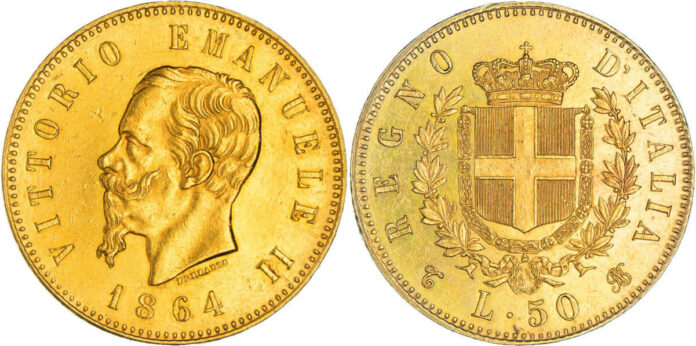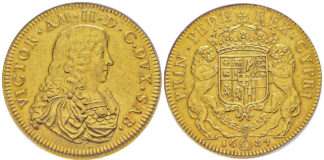Gold from Portugal, France and Italy
If you collect pieces from Portugal, France, Genoa, Casa Savoia or USA, be sure to save the date: on Saturday, 25 March 2023, Éditions Victor Gadoury in Monaco will offer important special collections on all five topics. Francesco and Federico Pastrone invite you to the elegant Hôtel Méridien Beach Plaza. A splendid opportunity to combine your passion for numismatics with a short break from the daily business.
Portuguese Medals
Portugal’s history was crucial for the development of Europe. Not only because the great explorers opened up new markets for European goods and because Portuguese ships provided the markets of the Old World with gold from Africa and Brazil – the great Lisbon Earthquake of 1755 also inspired the thinkers of the Enlightenment.
Portuguese medals commemorate this great history. Gadoury is able to offer gold, silver and bronze pieces, including numerous great rarities.
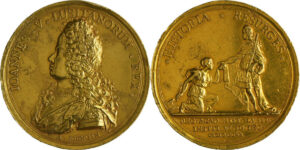
Let us begin with an extremely rare gold medal by João V, the Portuguese king under whose rule Brazilian gold made it possible to build the impressive Palace of Mafra. On 22 October 1721, the first anniversary of the Royal Academy, this medal was awarded to its most distinguished members. The King himself attended the ceremony and received gold specimen of the medal. An index of the Casa de Moeda tells us that only 12 gold specimens and 120 silver specimens were minted for the occasion. The official speaker, the Marquês de Abrantes, pointed out in his eulogy that the coin design was inspired by a sesterce of the Roman Emperor Vespasian.
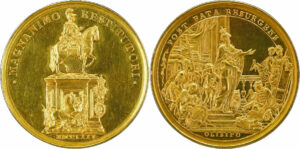
Another example is the extremely rare medal that was issued to celebrate the erection of a monument for José I. During his reign, the terrible Lisbon Earthquake took place. Under the leadership of the Marquês de Pombal, the people affected by the earthquake were given fast and effective help and the country took on the task of rebuilding Lisbon. Part of this construction project was the Praça do Comércio, where the customs and harbour administration was established. To this day, the statue for whose erection this medal was issued can be admired in the centre of the square.

The last medal in this group that we would like to present recalls Queen Maria I, the first woman on the Portuguese royal throne. The fact that she was the ruler of Portugal is shown on the medal’s obverse, which clearly puts Maria in the foreground. She and her husband Peter III had to wait a long time until they got children. Therefore, Maria vowed to build a church for the Convent of the Most Sacred Heart of Jesus. In fact, following this a first son was born in 1761; another two sons and three daughters followed. Maria had to wait for her accession to the throne in 1777 until she could actually plan a new church. In 1779, the foundation stone was laid. The medal was created to celebrate this occasion. When the church was completed in 1790, the son who had prompted its construction had already died of smallpox. After his mother’s death, his younger brother João VI took over the rule in 1816.
French Gold Coins from Napoleon I to the Third Republic
Do you collect French gold coins by year and mint? In that case, the Gadoury auction house has an extensive offer for you, including many great rarities: among the exactly 100 lots of modern French gold coins are extremely rare years and mints such as Turin (year 14 U), Perpignan (1818 Q), Turin (1818 U), La Rochelle (1809 H), Bordeaux (1813 K), Turin (1813 U), Genoa (1814 CL) for 20-franc pieces and Turin (year 14 U) and Limoges (1807 I) for 40-franc pieces.
Gold Coins from Genoa
In the Middle Ages and the beginnings of the early modern period, the Serenissima Repubblica di Genova was at least as powerful economically – if not more powerful – than its rivals Florence and Venice. Part of this power were Genoese gold coins, which circulated in the markets of the world. Those interested in Genoese coinage will have the unique opportunity to choose from a rich offer of partly extremely rare pieces at the upcoming Gadoury auction sale. The time frame of the 171 lots ranges from the High Middle Ages with the first genovini d’oro to Napoleon’s gold coins, minted in Genoa in 1813.
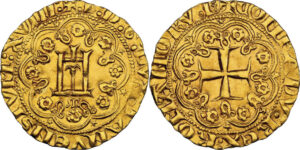
As a first rarity, let us mention an extremely rare genovino d’oro by Barnaba di Goano, who helped put an end to the civil war of 1414 and 1415. He was elected doge in 1415 but lost his office as early as three months later. Some bad decisions had enabled intriguers to replace him. His short reign is the reason why this coin is so extremely rare. It is all the more impressive that NGC graded this rarity MS62.

About half a century later, a genovino by Ludovico di Campofregoso was created. He held the office of doge for about 47 months, spread over three terms. Ludovico was a Fregoso, i.e. he was from the large family that provided the highest number of doges in the history of Genoa. A great commander himself, he became doge for the first time in December 1447 and stepped down in September 1450. In late July 1461, Ludovico became doge for the second time. But his cousin Paolo, who also held the office of Archbishop of Genoa, deposed him. Less than three weeks later, Ludovico was doge again, but Paolo succeeded a second time – and this time for good – in taking the reins from him. However, Paolo’s tenure was not a successful one either. The Council of Elders deposed him and placed Genoa under the rule of Milan. The fiorino offered at Gadoury recalls this exciting period, is very rare and of outstanding quality. PCGS graded it MS63.
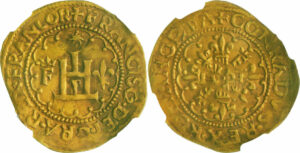
For all those interested in European history, this écu au soleil is a central piece. King Francis I of France had it minted in Genoa from 1527-1528. Francis, who disputed Charles V’s rule in Italy, was taken prisoner in 1525 in the Battle of Pavia. He was released in 1526 but had to sign a peace agreement that, among other things, stipulated that Spain was the ruler of Genoa. However, as soon as Francis I was free, he revoked all the concessions. The Genoese issue bearing his name is nothing but a declaration of war against Charles V.
Gadoury is in a position to offer an entire series of impressive 5-doppie pieces, which feature Virgin Mary with Child Jesus on the obverse. All of them are remarkable, but one stands out. The 1640 5-doppie piece was graded MS63 by NGC.
Gold Coins of Casa Savoia
Once again, we present pieces from the royal collection of Casa Savoia coinage. As was the case with the other parts of this extensive collection, connoisseurs will find numerous extremely rare gold pieces in excellent condition. The high quality of the offer is demonstrated by the fact that among the 296 lots are 33 pieces with five-digit estimates, one is even estimated at 120,000 euros. It is an extremely rare 50-lira piece, of which 103 specimens were minted in Turin in 1864. Lot No. 616 is even rarer. Only 30 specimens were minted in Rome in 1927 of this 100-lira piece by Vittorio Emmanuele III. Its condition is remarkable too: NGC graded it MS60. Of even better quality is the extremely rare 1925 pattern offered as lot No. 615, it was graded PF62 MATTE by NGC.
However, these rarities should not conceal one thing: collectors with a “normal” budget will also find a wealth of pieces at this Gadoury auction sale. There are many pieces with estimates in the lower three-digit range, starting at 100 euros. Thus, it is worthwhile for every collector to take a close look.
USA
Once again, Gadoury is able to present a rich selection of US gold coins, including numerous rare years and mints. At this point we limit our list to:
- 20 dollars, Carson City (1872). NGC AU58
- 10 dollars, Philadelphia, 1839 overstruck on 1838. PCGS AU58
- 10 dollars, New Orleans (1883). PCGS XF45. Only 40-50 specimens are known of
- 10 dollars, Carson City (1892). PCGS MS62
World Coins
The auction is rounded off by 30 lots with world coins. The offer ranges from antiquity to the present, from an aureus by Emperor Augustus to contemporary commemorative coins from China and Russia, including six gold coins from Poland. Along with several Polish ducats, the most remarkable among them is the 1650 triple ducat from Danzig minted under John II Casimir, featuring a magnificent city view.
You can order the catalogue at Éditions Victor Gadoury, 57, rue Grimaldi, 98000 Monaco; phone: +377 93 25 12 96; fax: +377 93 50 13 39; email.
You can view all lots here.
For further information, visit the Éditions Victor Gadoury website.



